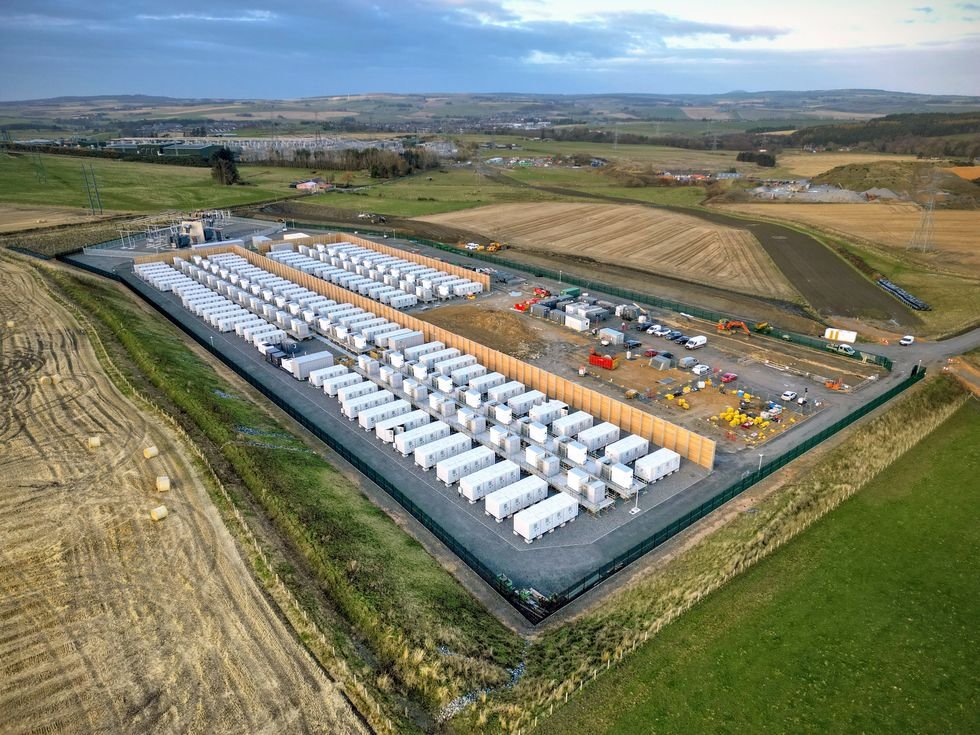
A grid-scale battery in the Scottish Highlands got a chance to prove its mettle in March when, 11 days after it started up, a massive wood-burning generator in northern England shut down unexpectedly. Suddenly 1,877 megawatts of supply was missing, causing the 50-hertz frequency of the grid’s alternating current to crash below its 49.8-Hz operating limit in just 8 seconds.
But the new 200-MW battery station leapt into action within milliseconds, releasing extra power to help arrest the frequency collapse and keep the grid running.
Conventional fossil-fuel generators have historically helped thwart these kinds of problems. With the inertia of their spinning rotors, their kinetic energy provides a buffer against rapid swings in frequency and voltage. But the response in the Highlands was one of the world’s first examples of a grid-scale battery commissioned to do this kind of grid-stabilizing job.
Without moving parts, the lithium battery storage site—the largest in Europe and located Blackhillock, Scotland—simulates inertia using power electronics. And in an innovative twist, the battery site can also provide short-circuit current in response to a fault, just like conventional power generators.
Four more of these battery sites are under construction in Scotland.
How Do Grid-Forming Inverters Work?
The batteries can deliver these stabilizing services thanks to their advanced grid-forming inverters that convert direct current from lithium batteries into alternating current for the grid, and vice versa when the batteries are charging. Rather than ‘following’ the grid’s frequency and voltage the way nearly all other grid-scale inverters do, grid-forming inverters march to their own drum, and can sometimes act faster than conventional generators.
“These grid-forming inverters that we’re installing in Scotland—nobody is doing that,” says Julian Leslie, chief engineer and strategic energy planning director for the National Energy System Operator (NESO), based in Warwick, England. Andy Hoke, an expert in grid-forming technology and principal engineer at the U.S. National Renewable Energy Lab, says Scotland’s additions definitely push the envelope. “They’re super exciting projects,” says Hoke.
Can the UK Operate Without Gas Plants?
NESO is relying on grid-forming batteries to help achieve an ambitious goal that it set for 2025: to show that the United Kingdom can live without its dextrous, stability-boosting gas-fired plants. The U.K. shut down its last coal-fired power plant last year, and by the end of this year NESO plans to demonstrate that it can also operate without gas plants.
“By the end of the year we’ll have a couple of hours with zero carbon operation, which is going to be amazing,” says Leslie. It would be the world’s largest demonstration of fossil-free grid operation.
This is no ‘eco ego’ stunt. Increased stability from power electronics means more solar and wind generators can connect to the grid, and minimizes how often NESO must curtail their generation. London-based Zenobē, the grid battery operator behind three of the new Scottish battery sites, estimates that Blackhillock alone will save consumers £309 million (US $418 million) over 15 years.
Scotland’s Energy Transition Challenge
Scotland is ground zero for the U.K.’s grid decarbonization challenge. It has already closed not only its coal plants, but also its gas plants. Its one remaining nuclear plant, Torness, will shut down by 2030. With Torness’s closing, the only synchronous generators left in Scotland will be its few remaining small hydropower plants—machines that have for so long maintained the stability of the grid with the mechanical speed of their rotors. The wind- and solar-power installations the country is betting on for its energy future have grid-following inverters that contribute little to grid stability.
So solutions are needed. Operators worldwide have been reinforcing their grids by installing synchronous condensers—standalone synchronous generators whose rotors are kept spinning using grid power. Stored kinetic energy is then available when the grid stumbles, much like a conventional power plant. The Baltic states ordered a raft of these dedicated stabilizers ahead of their recent shift from syncing with Russia’s grid to Europe’s.
NESO, however, is taking a different tack in its preparation for zero-carbon operation. Instead of simply specifying synchronous condensers, NESO identified where it needed more stability and invited developers to pitch tech solutions. Grid-forming batteries scored big in NESO’s 2022 tender. The £323-million ($427-million) package of winning bids included Scotland’s advanced grid-scale batteries along with five synchronous condensers.
Short-Circuit Current Innovation
What’s most innovative about the grid-forming batteries is that NESO mandated that they provide short-circuit current, just like synchronous generators do. When falling trees and other mishaps connect a transmission line to the ground, short-circuiting the grid, power plants’ synchronous generators release a surge of current that helps prop up voltage. The blast of current is also an important signal that triggers grid-protecting relays to open and isolate the faulted transmission segment in a fraction of a second.
Mimicking that behavior is difficult for power electronics. A grid-forming inverter sustains its own voltage and frequency by delivering whatever current is required. When voltage drops, the controller immediately allows more current through the inverter’s transistors. So far so good. But inverters can quickly hit a wall. High currents are like kryptonite for power electronics, producing heat that can quickly fry their transistors. As a result, inverters usually operate at only 10 to 20 percent above their current rating, whereas currents from a synchronous generator can increase 700 percent during a fault.
The simplest way to increase current capacity is to add more transistors, but that’s pricey for the insulated-gate bipolar transistors used in transmission-level converters. German inverter producer SMA Solar Technology, which supplied Blackhillock’s inverter, found a cheaper way to meet the need, taking advantage of the brevity of short-circuit current.
They programmed Blackhillock’s inverter to hit 250 percent above nominal current to deliver the 140 millisecond pulse that NESO requires, says Aaron Gerdemann, a business development manager for SMA. After that, the device will back down, allowing the circuits to cool.
Can Power Electronics Stabilize the Grid?
Zenobē’s global director of network infrastructure, Semih Oztreves, predicts that grid-forming batteries will ultimately corner the stability market thanks to their inherent multi-functionality. While synchronous condensers mostly sit idle, waiting for a rare grid fault, Zenobē’s advanced batteries earn daily revenue by doing what most other storage sites do. For example, they arbitrage energy, absorbing power when it’s cheap and selling when supplies get tight.
But the short-circuit chops of grid-forming batteries haven’t yet faced a real-life test. Until then, doubts linger about whether transmission relays will respond appropriately to the inverters’ digitally-defined surge of current. In a report last year for Australian grid operator Transgrid, one expert advised against over-reliance on grid-forming inverters for short-circuit current, saying that it would carry “high to very high risk.” The utility later announced 10 synchronous condensers and 5 grid-forming batteries to bolster its grid.
So for now, with the stakes high, keeping a few of the pricier synchronous condensers in the mix probably makes sense, says Hoke. “It might not be the cost-optimal solution, but it may be the wise solution,” he says.



